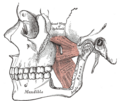Condyloid process
| Condyloid process | |
|---|---|
 Mandible. Outer surface. Side view. (Condyle and neck labeled at upper right.) | |
| Details | |
| Identifiers | |
| Latin | processus condylaris mandibulae |
| MeSH | D008335 |
| TA98 | A02.1.15.035 |
| TA2 | 872 |
| FMA | 52836 |
| Anatomical terms of bone | |
The condyloid process is thicker than the coronoid, and consists of two portions: the condyle, and the constricted portion which supports it, the neck.
Condyle
The condyle presents an articular surface for articulation with the articular disk of the temporomandibular joint; it is convex from before backward and from side to side, and extends farther on the posterior than on the anterior surface.
Its long axis is directed medialward and slightly backward, and if prolonged to the middle line will meet that of the opposite condyle near the anterior margin of the foramen magnum.
At the lateral extremity of the condyle is a small tubercle for the attachment of the temporomandibular ligament.
Neck
The neck is flattened from before backward, and strengthened by ridges which descend from the forepart and sides of the condyle.
Its posterior surface is convex; its anterior presents a depression for the attachment of the Pterygoideus externus.
See also
Additional images
-
The Pterygoidei; the zygomatic arch and a portion of the ramus of the mandible have been removed.
-
Horizontal section through left ear; upper half of section.
External links
- lesson1 at The Anatomy Lesson by Wesley Norman (Georgetown University)
- Anatomy photo:22:os-1001 at the SUNY Downstate Medical Center - "Osteology of the Skull: Mandible of Intact Skull"
- Mandibular+condyle at the U.S. National Library of Medicine Medical Subject Headings (MeSH)
- Template:RocheLexicon
![]() This article incorporates text in the public domain from page 174 of the 20th edition of Gray's Anatomy (1918)
This article incorporates text in the public domain from page 174 of the 20th edition of Gray's Anatomy (1918)


